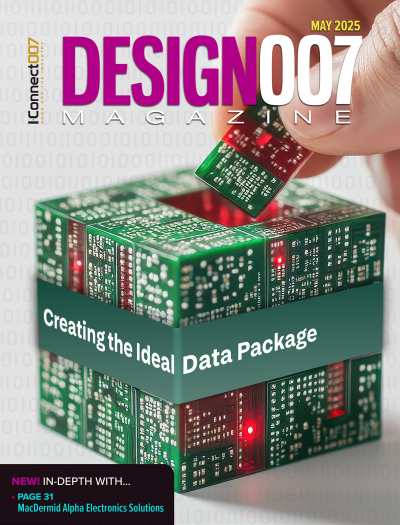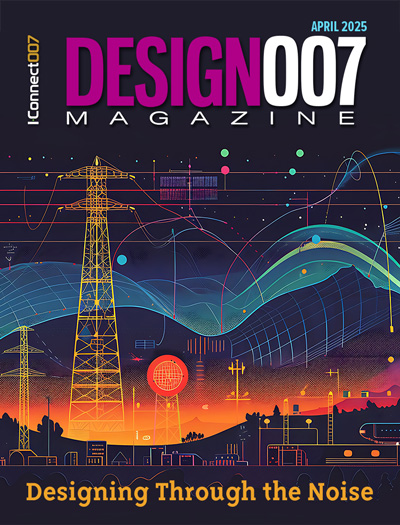-

-
News
News Highlights
- Books
Featured Books
- design007 Magazine
Latest Issues
Current Issue
All About That Route
Most designers favor manual routing, but today's interactive autorouters may be changing designers' minds by allowing users more direct control. In this issue, our expert contributors discuss a variety of manual and autorouting strategies.

Creating the Ideal Data Package
Why is it so difficult to create the ideal data package? Many of these simple errors can be alleviated by paying attention to detail—and knowing what issues to look out for. So, this month, our experts weigh in on the best practices for creating the ideal design data package for your design.

Designing Through the Noise
Our experts discuss the constantly evolving world of RF design, including the many tradeoffs, material considerations, and design tips and techniques that designers and design engineers need to know to succeed in this high-frequency realm.
- Articles
- Columns
- Links
- Media kit
||| MENU - design007 Magazine
Zuken’s CR-8000 2017 Supports Electronic and Electrical Design Convergence
July 12, 2017 | ZukenEstimated reading time: 3 minutes
Zuken has launched CR-8000 2017, the first release of this platform to enhance electrical and electronic co-design at the architectural design phase.
CR-8000 is the industry’s only 3D product-centric design solution with architecture design, concurrent 3D multi-board support, and chip/package/board co-design capabilities. CR-8000 integrates directly with Zuken’s DS-2, a comprehensive electronic and electrical design data management platform which addresses today’s complex enterprise level data needs.
“PCB-centric design methodologies are shifting to a product or system-centric approach with more cross-domain collaboration. Part of that shift is the growing need for architecture design and optimization before you enter detailed design,” said Bob Potock, Vice President of Marketing at Zuken USA, Inc. “System Planner 2017 now addresses the need for wire harness interconnectivity between boards at the architecture phase, and delivers the design information directly to the design tool.”
CR-8000 2017 contains more than 150 user-driven enhancements and new features spanning design productivity, rule checking and usability across the product family.
Electronic and electrical design convergence
With the rise in products containing both electronic and electrical design objects, the need for tight design integration across the domains becomes increasingly urgent. System Planner, CR-8000’s architecture design and optimization tool, addresses this need as a multi-domain design tool for PCB-based systems: its visionaries cover functional design, multi-board planning, mechanical fit and parametric analysis. With System Planner 2017 users can add electrical co-design to the architecture design phase, and export directly to E3.series, Zuken’s electrical design tool suite. This new capability enables cross-domain architecture optimization, and eliminates the need for data reentry.
Architecture design expands library and modular design support
With increased product complexity comes a growing need for architectural design and optimization. System Planner 2017 improves multi-board system optimization through new module management capabilities. Design module status can be verified to detect updates based on a set of user-defined rules. In addition, partitioning a design module across blocks or boards is now possible on a schematic page basis, allowing for improved architectural design optimization.
Reference designator assignments can be made, or auto-generated, during architecture design on a block-by-block basis, allowing for more collaboration with detailed design. Design rule checks can also be applied to manage unassigned or duplicate reference designators. In addition, during physical optimization, components within the functional block may be identified and moved as a single unit, making floor planning easy and efficient.
Productivity enhancements
CR-8000 2017 contains more than 150 user driven enhancements and new features:
- Support for multi-board EMC now checks return paths on electrical nets that run across multiple boards. Reporting is carried out on a net-by-net basis.
- Expanded MCAD co-design by importing figures from a board model created using mechanical CAD. Supported systems include CATIA V5, Creo, NX, SolidWorks, STEP, Parasolid, and ACIS.
- Expanded 3D model support when exporting a full multi-board design with an enclosure in 3D PDF format.
- New functionality enabling users to generate bumps in differential pairs while checking the difference in length between positive and negative routes.
About Zuken
Zuken is a global provider of leading-edge software and consulting services for electrical and electronic design and manufacturing. Founded in 1976, Zuken has the longest track record of technological innovation and financial stability in the electronic design automation (EDA) software industry. The company’s extensive experience, technological expertise and agility, combine to create world-class software solutions. Zuken’s transparent working practices and integrity in all aspects of business produce long-lasting and successful customer partnerships that make Zuken a reliable long-term business partner.
Zuken is focused on being a long-term innovation and growth partner. The security of choosing Zuken is further reinforced by the company’s people—the foundation of Zuken’s success. Coming from a wide range of industry sectors, specializing in many different disciplines and advanced technologies, Zuken’s people relate to and understand each company’s unique requirements. For more information about the company and its products, click here.
Suggested Items
DownStream Acquisition Fits Siemens’ ‘Left-Shift’ Model
06/26/2025 | Andy Shaughnessy, I-Connect007I recently spoke to DownStream Technologies founder Joe Clark about the company’s acquisition by Siemens. We were later joined by A.J. Incorvaia, Siemens’ senior VP of electronic board systems. Joe discussed how he, Rick Almeida, and Ken Tepper launched the company in the months after 9/11 and how the acquisition came about. A.J. provides some background on the acquisition and explains why the companies’ tools are complementary.
Elementary Mr. Watson: Retro Routers vs. Modern Boards—The Silent Struggle on Your Screen
06/26/2025 | John Watson -- Column: Elementary, Mr. WatsonThere's a story about a young woman preparing a holiday ham. Before putting it in the pan, she cuts off the ends. When asked why, she shrugs and says, "That's how my mom always did it." She asks her mother, who gives the same answer. Eventually, the question reaches Grandma, who laughs and says, "Oh, I only cut the ends off because my pan was too small." This story is a powerful analogy for how many PCB designers approach routing today.
Siemens Turbocharges Semiconductor and PCB Design Portfolio with Generative and Agentic AI
06/24/2025 | SiemensAt the 2025 Design Automation Conference, Siemens Digital Industries Software today unveiled its AI-enhanced toolset for the EDA design flow.
Cadence AI Autorouter May Transform the Landscape
06/19/2025 | Andy Shaughnessy, Design007 MagazinePatrick Davis, product management director with Cadence Design Systems, discusses advancements in autorouting technology, including AI. He emphasizes a holistic approach that enhances placement and power distribution before routing. He points out that younger engineers seem more likely to embrace autorouting, while the veteran designers are still wary of giving up too much control. Will AI help autorouters finally gain industry-wide acceptance?
Beyond Design: The Metamorphosis of the PCB Router
06/18/2025 | Barry Olney -- Column: Beyond DesignThe traditional PCB design process is often time-consuming and labor-intensive. Routing a complex PCB layout can consume up to 30% of a designer’s time, and addressing this issue is not straightforward. We have all encountered this scenario: You spend hours setting the constraints and finally hit the Go button, only to be surprised by the lack of visual appeal and the obvious flaws in the result.


